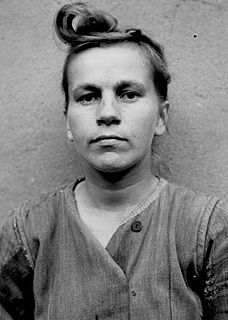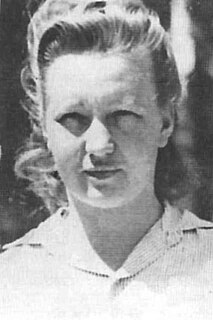| Margarete Gallinat | |
|---|---|
| Born | 1894 East Prussian Puntigam |
| Nationality | German |
| Occupation | Chief supervisor at Kamp Vught |
| Known for | Supervisor at Ravensbrück concentration camp |
Oberaufseherin Margarete Gallinat (born 1894, date of death unknown) was the chief supervisor at Kamp Vught, Netherlands. She later became a supervisor at Ravensbrück concentration camp. [1] [2]

The Aufseherinnen were female guards in German concentration camps during the Holocaust. Of the 55,000 guards who served in German concentration camps, about 3,700 were women. In 1942, the first female guards arrived at Auschwitz and Majdanek from Ravensbrück. The year after, the Nazis began conscripting women because of a guard shortage. The German title for this position, Aufseherin means female overseer or attendant. Later female guards were dispersed to Bolzano (1944–45), Kaiserwald-Riga (1943–44), Mauthausen, Stutthof (1942–45), Vaivara (1943–44), Vught (1943–44), and at other Nazi concentration camps, subcamps, work camps, detention camps, etc.

Herzogenbusch concentration camp was a Nazi concentration camp located in Vught near the city of 's-Hertogenbosch, Netherlands. Herzogenbusch was, with Natzweiler-Struthof in occupied France, the only concentration camp run directly by the SS in western Europe outside Germany. The camp was first used in 1943 and held 31,000 prisoners. 749 prisoners died in the camp, and the others were transferred to other camps shortly before the camp was liberated by the Allied Forces in 1944. After the war the camp was used as a prison for Germans and Dutch collaborators. Today there is a visitors' center with exhibitions and a national monument remembering the camp and its victims. The camp is now a museum.

The Netherlands is a country located mainly in Northwestern Europe. The European portion of the Netherlands consists of twelve separate provinces that border Germany to the east, Belgium to the south, and the North Sea to the northwest, with maritime borders in the North Sea with Belgium, Germany and the United Kingdom. Together with three island territories in the Caribbean Sea—Bonaire, Sint Eustatius and Saba— it forms a constituent country of the Kingdom of the Netherlands. The official language is Dutch, but a secondary official language in the province of Friesland is West Frisian.









